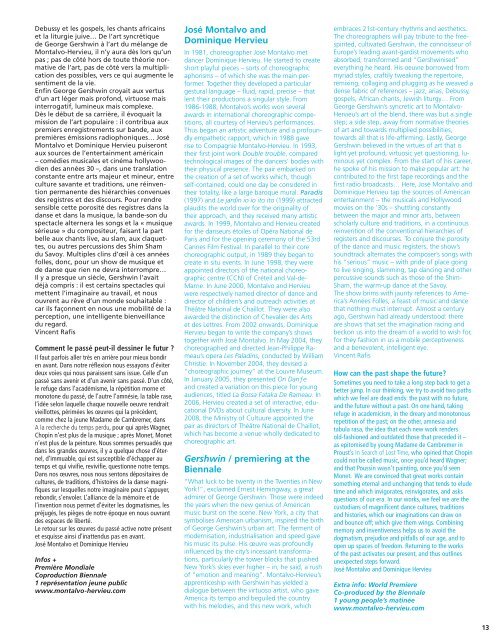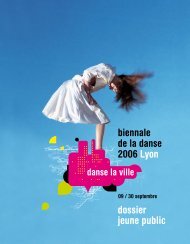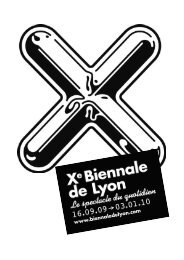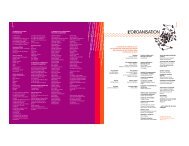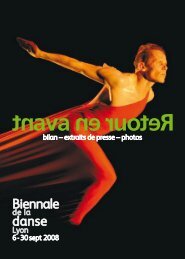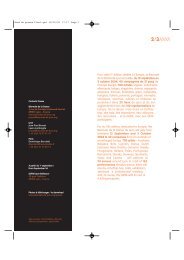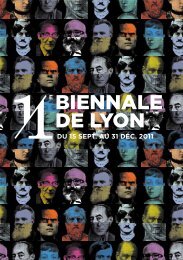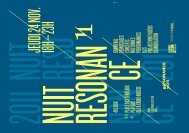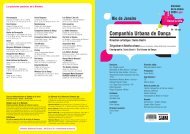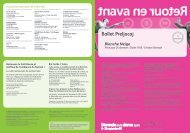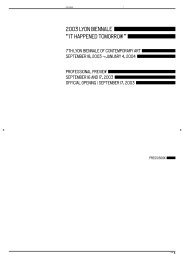Retour en Avant / Past Forward Biennale de la Danse Lyon - France
Retour en Avant / Past Forward Biennale de la Danse Lyon - France
Retour en Avant / Past Forward Biennale de la Danse Lyon - France
- No tags were found...
Create successful ePaper yourself
Turn your PDF publications into a flip-book with our unique Google optimized e-Paper software.
Debussy et les gospels, les chants africainset <strong>la</strong> liturgie juive… De l’art syncrétique<strong>de</strong> George Gershwin à l’art du mé<strong>la</strong>nge <strong>de</strong>Montalvo-Hervieu, il n’y aura dès lors qu’unpas ; pas <strong>de</strong> côté hors <strong>de</strong> toute théorie normative<strong>de</strong> l’art, pas <strong>de</strong> côté vers <strong>la</strong> multiplication<strong>de</strong>s possibles, vers ce qui augm<strong>en</strong>te les<strong>en</strong>tim<strong>en</strong>t <strong>de</strong> <strong>la</strong> vie.Enfin George Gershwin croyait aux vertusd’un art léger mais profond, virtuose maisinterrogatif, lumineux mais complexe.Dès le début <strong>de</strong> sa carrière, il évoquait <strong>la</strong>mission <strong>de</strong> l’art popu<strong>la</strong>ire : il contribua auxpremiers <strong>en</strong>registrem<strong>en</strong>ts sur ban<strong>de</strong>, auxpremières émissions radiophoniques… JoséMontalvo et Dominique Hervieu puiserontaux sources <strong>de</strong> l’<strong>en</strong>tertainm<strong>en</strong>t américain– comédies musicales et cinéma hollywoodi<strong>en</strong><strong>de</strong>s années 30 –, dans une trans<strong>la</strong>tionconstante <strong>en</strong>tre arts majeur et mineur, <strong>en</strong>treculture savante et traditions, une réinv<strong>en</strong>tionperman<strong>en</strong>te <strong>de</strong>s hiérarchies conv<strong>en</strong>ues<strong>de</strong>s registres et <strong>de</strong>s discours. Pour r<strong>en</strong>dres<strong>en</strong>sible cette porosité <strong>de</strong>s registres dans <strong>la</strong>danse et dans <strong>la</strong> musique, <strong>la</strong> ban<strong>de</strong>-son duspectacle alternera les songs et <strong>la</strong> « musiquesérieuse » du compositeur, faisant <strong>la</strong> partbelle aux chants live, au s<strong>la</strong>m, aux c<strong>la</strong>quettes,ou autres percussions <strong>de</strong>s Shim Shamdu Savoy. Multiples clins d’œil à ces annéesfolles, donc, pour un show <strong>de</strong> musique et<strong>de</strong> danse que ri<strong>en</strong> ne <strong>de</strong>vra interrompre…Il y a presque un siècle, Gershwin l’avaitdéjà compris : il est certains spectacles quimett<strong>en</strong>t l’imaginaire au travail, et nousouvr<strong>en</strong>t au rêve d’un mon<strong>de</strong> souhaitable :car ils façonn<strong>en</strong>t <strong>en</strong> nous une mobilité <strong>de</strong> <strong>la</strong>perception, une intellig<strong>en</strong>te bi<strong>en</strong>veil<strong>la</strong>ncedu regard.Vinc<strong>en</strong>t RafisComm<strong>en</strong>t le passé peut-il <strong>de</strong>ssiner le futur ?Il faut parfois aller très <strong>en</strong> arrière pour mieux bondir<strong>en</strong> avant. Dans notre réflexion nous essayons d’éviter<strong>de</strong>ux voies qui nous paraiss<strong>en</strong>t sans issue. Celle d’unpassé sans av<strong>en</strong>ir et d’un av<strong>en</strong>ir sans passé. D’un côté,le refuge dans l’académisme, <strong>la</strong> répétition morne etmonotone du passé, <strong>de</strong> l’autre l’amnésie, <strong>la</strong> table rase,l’idée selon <strong>la</strong>quelle chaque nouvelle oeuvre r<strong>en</strong>draitvieillottes, périmées les œuvres qui <strong>la</strong> précèd<strong>en</strong>t,comme chez <strong>la</strong> jeune Madame <strong>de</strong> Cambremer, dansA <strong>la</strong> recherche du temps perdu, pour qui après Wagner,Chopin n’est plus <strong>de</strong> <strong>la</strong> musique ; après Monet, Monetn’est plus <strong>de</strong> <strong>la</strong> peinture. Nous sommes persuadés quedans les gran<strong>de</strong>s œuvres, il y a quelque chose d’éternel,d’immuable, qui est susceptible d’échapper autemps et qui vivifie, revivifie, questionne notre temps.Dans nos œuvres, nous nous s<strong>en</strong>tons dépositaires <strong>de</strong>cultures, <strong>de</strong> traditions, d’histoires <strong>de</strong> <strong>la</strong> danse magnifiquessur lesquelles notre imaginaire peut s’appuyer,rebondir, s’<strong>en</strong>voler. L’alliance <strong>de</strong> <strong>la</strong> mémoire et <strong>de</strong>l’inv<strong>en</strong>tion nous permet d’éviter les dogmatismes, lespréjugés, les pièges <strong>de</strong> notre époque <strong>en</strong> nous ouvrant<strong>de</strong>s espaces <strong>de</strong> liberté.Le retour sur les œuvres du passé active notre prés<strong>en</strong>tet esquisse ainsi d’inatt<strong>en</strong>dus pas <strong>en</strong> avant.José Montalvo et Dominique HervieuInfos +Première MondialeCoproduction Bi<strong>en</strong>nale1 représ<strong>en</strong>tation jeune publicwww.montalvo-hervieu.comJosé Montalvo andDominique HervieuIn 1981, choreographer José Montalvo metdancer Dominique Hervieu. He started to createshort p<strong>la</strong>yful pieces – sorts of choreographicaphorisms – of which she was the main performer.Together they <strong>de</strong>veloped a particu<strong>la</strong>rgestural <strong>la</strong>nguage – fluid, rapid, precise – thatl<strong>en</strong>t their productions a singu<strong>la</strong>r style. From1986-1988, Montalvo’s works won severa<strong>la</strong>wards in international choreographic competitions,all courtesy of Hervieu’s performances.Thus began an artistic adv<strong>en</strong>ture and a profoundlyempathetic rapport, which in 1988 gaverise to Compagnie Montalvo-Hervieu. In 1993,their first joint work Double trouble, comparedtechnological images of the dancers’ bodies withtheir physical pres<strong>en</strong>ce. The pair embarked onthe creation of a set of works which, thoughself-contained, could one day be consi<strong>de</strong>red intheir totality, like a <strong>la</strong>rge baroque mural. Paradis(1997) and Le jardin io io ito ito (1999) attractedp<strong>la</strong>udits the world over for the originality oftheir approach, and they received many artisticawards. In 1999, Montalvo and Hervieu createdfor the danseurs étoiles of Opéra National <strong>de</strong>Paris and for the op<strong>en</strong>ing ceremony of the 53rdCannes Film Festival. In parallel to their corechoreographic output, in 1989 they began tocreate in situ ev<strong>en</strong>ts. In June 1998, they wereappointed directors of the national choreographicc<strong>en</strong>tre (CCN) of Créteil and Val-<strong>de</strong>-Marne. In June 2000, Montalvo and Hervieuwere respectively named director of dance anddirector of childr<strong>en</strong>’s and outreach activities atThéâtre National <strong>de</strong> Chaillot. They were alsoawar<strong>de</strong>d the distinction of Chevalier <strong>de</strong>s Artset <strong>de</strong>s Lettres. From 2002 onwards, DominiqueHervieu began to write the company’s showstogether with José Montalvo. In May 2004, theychoreographed and directed Jean-Philippe Rameau’sopera Les Pa<strong>la</strong>dins, conducted by WilliamChristie. In November 2004, they <strong>de</strong>vised a“choreographic journey” at the Louvre Museum.In January 2005, they pres<strong>en</strong>ted On Danƒeand created a variation on this piece for youngaudi<strong>en</strong>ces, titled La Bossa Fataka De Rameau. In2006, Hervieu created a set of interactive, educationalDVDs about cultural diversity. In June2008, the Ministry of Cultuure appointed thepair as directors of Théâtre National <strong>de</strong> Chaillot,which has become a v<strong>en</strong>ue wholly <strong>de</strong>dicated tochoreographic art.Gershwin / premiering at theBi<strong>en</strong>nale“What luck to be tw<strong>en</strong>ty in the Tw<strong>en</strong>ties in NewYork!”, exc<strong>la</strong>imed Ernest Hemingway, a greatadmirer of George Gershwin. Those were in<strong>de</strong>edthe years wh<strong>en</strong> the new g<strong>en</strong>ius of Americanmusic burst on the sc<strong>en</strong>e. New York, a city thatsymbolises American urbanism, inspired the birthof George Gershwin’s urban art. The ferm<strong>en</strong>t ofmo<strong>de</strong>rnisation, industrialisation and speed gavehis music its pulse. His œuvre was profoundlyinflu<strong>en</strong>ced by the city’s incessant transformations,particu<strong>la</strong>rly the tower blocks that pushedNew York’s skies ever higher – in, he said, a rushof “emotion and meaning”. Montalvo-Hervieu’sappr<strong>en</strong>ticeship with Gershwin has yiel<strong>de</strong>d adialogue betwe<strong>en</strong> the virtuoso artist, who gaveAmerica its tempo and beguiled the countrywith his melodies, and this new work, whichembraces 21st-c<strong>en</strong>tury rhythms and aesthetics.The choreographers will pay tribute to the freespirited,cultivated Gershwin, the connoisseur ofEurope’s leading avant-gardist movem<strong>en</strong>ts whoabsorbed, transformed and “Gershwinised”everything he heard. His oeuvre borrowed frommyriad styles, craftily tweaking the repertoire,remixing, col<strong>la</strong>ging and plugging as he weaved ad<strong>en</strong>se fabric of refer<strong>en</strong>ces – jazz, arias, Debussy,gospels, African chants, Jewish liturgy… FromGeorge Gershwin’s syncretic art to Montalvo-Hervieu’s art of the bl<strong>en</strong>d, there was but a singlestep; a si<strong>de</strong> step, away from normative theoriesof art and towards multiplied possibilities,towards all that is life-affirming. Lastly, GeorgeGershwin believed in the virtues of art that islight yet profound, virtuosic yet questioning, luminousyet complex. From the start of his career,he spoke of his mission to make popu<strong>la</strong>r art: hecontributed to the first tape recordings and thefirst radio broadcasts… Here, José Montalvo andDominique Hervieu tap the sources of American<strong>en</strong>tertainm<strong>en</strong>t – the musicals and Hollywoodmovies on the ’30s – shuttling constantlybetwe<strong>en</strong> the major and minor arts, betwe<strong>en</strong>scho<strong>la</strong>rly culture and traditions, in a continuousreinv<strong>en</strong>tion of the conv<strong>en</strong>tional hierarchies ofregisters and discourses. To conjure the porosityof the dance and music registers, the show’ssoundtrack alternates the composer’s songs withhis “serious” music – with pri<strong>de</strong> of p<strong>la</strong>ce goingto live singing, s<strong>la</strong>mming, tap dancing and otherpercussive sounds such as those of the Shim-Sham, the warm-up dance at the Savoy.The show brims with jaunty refer<strong>en</strong>ces to America’sAnnées Folles, a feast of music and dancethat nothing must interrupt. Almost a c<strong>en</strong>turyago, Gershwin had already un<strong>de</strong>rstood: thereare shows that set the imagination racing andbeckon us into the dream of a world to wish for,for they fashion in us a mobile perceptiv<strong>en</strong>essand a b<strong>en</strong>evol<strong>en</strong>t, intellig<strong>en</strong>t eye.Vinc<strong>en</strong>t RafisHow can the past shape the future?Sometimes you need to take a long step back to get abetter jump. In our thinking, we try to avoid two pathswhich we feel are <strong>de</strong>ad <strong>en</strong>ds: the past with no future,and the future without a past. On one hand, takingrefuge in aca<strong>de</strong>micism, in the dreary and monotonousrepetition of the past; on the other, amnesia andtabu<strong>la</strong> rasa, the i<strong>de</strong>a that each new work r<strong>en</strong><strong>de</strong>rsold-fashioned and outdated those that prece<strong>de</strong>d it –as epitomised by young Madame <strong>de</strong> Cambremer inProust’s In Search of Lost Time, who opined that Chopincould not be called music, once you’d heard Wagner;and that Poussin wasn’t painting, once you’d se<strong>en</strong>Monet. We are convinced that great works containsomething eternal and unchanging that t<strong>en</strong>ds to elu<strong>de</strong>time and which invigorates, reinvigorates, and asksquestions of our era. In our works, we feel we are thecustodians of magnific<strong>en</strong>t dance cultures, traditionsand histories, which our imaginations can draw onand bounce off; which give them wings. Combiningmemory and inv<strong>en</strong>tiv<strong>en</strong>ess helps us to avoid thedogmatism, prejudice and pitfalls of our age, and toop<strong>en</strong> up spaces of freedom. Returning to the worksof the past activates our pres<strong>en</strong>t, and thus outlinesunexpected steps forward.José Montalvo and Dominique HervieuExtra info: World PremiereCo-produced by the Bi<strong>en</strong>nale1 young people’s matinéewww.montalvo-hervieu.com13


